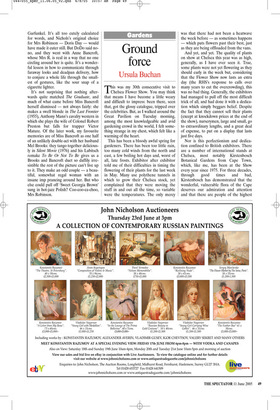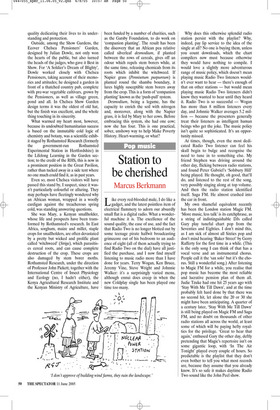Ground force
Ursula Buchan
This was my 30th consecutive visit to Chelsea Flower Show. You may think that means I have become a little weary and difficult to impress: been there, seen that, got the glossy catalogue, tripped over the celebrities. But, as I walked around the Great Pavilion on Tuesday morning, among the most knowledgeable and avid gardening crowd in the world, I felt something strange in my chest, which felt like a warming of the heart.
This has been a bloody awful spring for gardeners. There has been too little rain, too many cold winds from the north and east, a few boiling hot days and, worst of all, late frosts. Exhibitor after exhibitor told me of their difficulties in timing the flowering of their plants for the last week in May. Many use polythene tunnels in which to grow their Chelsea stock, yet complained that they were moving the stuff in and out all the time, so variable were the temperatures. The only mercy was that there had not been a heatwave the week before — as sometimes happens — which puts flowers past their best, just as they are being offloaded from the vans.
And yet, and yet. The quality of plants on show at Chelsea this year was as high, generally, as I have ever seen it. True, some plants were not yet flowering as they should early in the week but, considering that the Flower Show now lasts an extra day (the RHS’s response to calls over many years to cut the overcrowding), this was no bad thing. Generally, the exhibitors had managed to pull off the most difficult trick of all, and had done it with a dedication which simply beggars belief. Despite the fact that they cannot sell their plants (except at knockdown prices at the end of the show), nurserymen, large and small, go to extraordinary lengths, and a great deal of expense, to put on a display that lasts just five days.
Nor is this perfectionism and dedication confined to British exhibitors. There are a number of international stands at Chelsea, most notably Kirstenbosch Botanical Gardens from Cape Town, which, like me, has been at the Show every year since 1975. For three decades, through good times and bad, Kirstenbosch has demonstrated that the wonderful, vulnerable flora of the Cape deserves our admiration and attention and that there are people of the highest quality dedicating their lives to its understanding and protection.
Outside, among the Show Gardens, the Ecover Chelsea Pensioners’ Garden, designed by Julian Dowle, not only won the hearts of the public, but also turned the heads of the judges, who gave it Best in Show. For ‘A Soldier’s Dream of Blighty’, Dowle worked closely with Chelsea Pensioners, taking account of their memories and attitudes; he designed a garden in front of a thatched country pub, complete with pre-war vegetable cultivars, grown by the Pensioners, as well as village green, pond and all. In Chelsea Show Garden design terms it was the oldest of old hat, but the finish was excellent, and the whole thing touching in its sincerity.
What warmed my heart most, however, because its undoubted humanitarian success is based on the immutable cold logic of chemistry and botany, was a scientific exhibit staged by Rothamsted Research (formerly the government-run Rothamsted Experimental Station in Hertfordshire) in the Lifelong Learning in the Garden section; to the credit of the RHS, this is now in a prominent position in the Great Pavilion, rather than tucked away in a side tent where no one much could find it, as in past years.
Even so, most Chelsea visitors will have passed this stand by, I suspect, since it wasn’t particularly colourful or alluring. They may perhaps have fleetingly wondered why an African woman, wrapped in a woolly cardigan against the treacherous spring cold, was standing answering questions.
She was Mary, a Kenyan smallholder, whose life and prospects have been transformed by Rothamsted’s research. In East Africa, sorghum, maize and millet, staple crops for smallholders, are often devastated by a pretty but wicked and prolific plant called ‘witchweed’ (Striga), which parasitises cereal roots, and can cause complete destruction of the crop. These crops are also damaged by stem borer moths. Rothamsted Research, under the direction of Professor John Pickett, together with the International Centre of Insect Physiology and Ecology (no, I hadn’t either), the Kenya Agricultural Research Institute and the Kenyan Ministry of Agriculture, have been funded by a number of charities, such as the Gatsby Foundation, to do work on ‘companion planting’. The result has been the discovery that an African pea relative called silverleaf desmodium, if planted between the rows of cereals, gives off an odour which repels stem borers while, at the same time, releasing chemicals from its roots which inhibit the witchweed. If Napier grass (Pennisetum purpureum) is planted round the shamba boundary, it lures highly susceptible stem borers away from the crop. This is a form of ‘companion planting’ known as the ‘push-pull’ system.
Desmodium, being a legume, has the capacity to enrich the soil with nitrogen and, moreover, along with the Napier grass, it is fed by Mary to her cows. Before embracing this system, she had one cow; now she has four. This is one practical, sober, unshowy way to help Make Poverty History. Heart-warming, or what?



















































 Previous page
Previous page